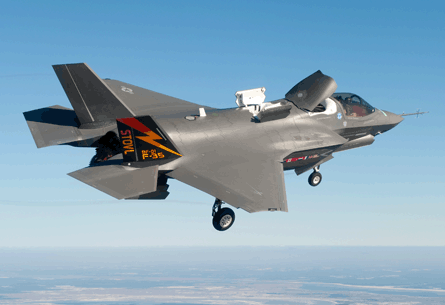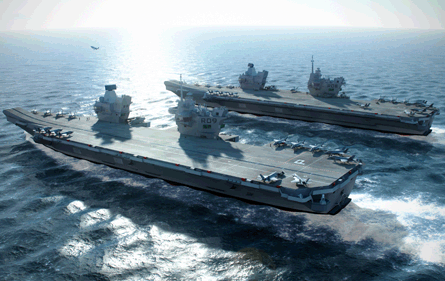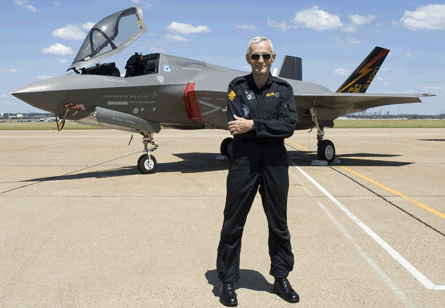As the USA's sole Level One partner on the F-35 Joint Strike Fighter, the UK has a pivotal role in the Pentagon's largest ever procurement effort as a customer and as an industrial participant.
Thanks to its status as one of Lockheed Martin's production partners on the Lightning II, BAE Systems is dramatically expanding its manufacturing capabilities in the north-west of England to prepare for a major ramp-up in work to occur by the middle of this decade.
With its responsibilities including the production of the aft fuselage and horizontal and vertical tails for every F-35 built, BAE has a roughly 16% stake in the JSF programme. This also covers its production of the heat-resistant nozzle bay door for the short take-off and vertical landing F-35B, which will enter service with the UK Royal Air Force and Royal Navy, the US Marine Corps and Italy.
 |
|---|
© Lockheed Martin |
BAE is also the lead company on the JSF's fuel system, and works with Martin-Baker on its pilot life support and escape system. It is also assisting with the F-35B's integration with the RN's Queen Elizabeth-class future aircraft carriers, each of which will be able to carry up to 36 fighters. Separately, its BAE Systems Inc business in the USA will supply electronic warfare equipment.
The scale of BAE's involvement has required major ongoing investment at its Samlesbury site in Lancashire. This was the location for the production of major components for the Eurofighter Typhoon, and previously played host to English Electric's manufacture of the UK's original Lightning fighter.
"The work at Samlesbury is across the whole programme," says Mick Ord, BAE's managing director, Lightning II, speaking at the company's one year-old headquarters building for JSF-related activities. The zero-emission structure cost over £26 million ($39 million) to build, and is part of a more than £200 million facilities transformation linked directly to the F-35.
Manufacturing activities at Samlesbury are now at a level where BAE ships one aircraft set of equipment to Lockheed's final assembly line in Fort Worth, Texas every 15 days, and its existing infrastructure could cut this to a nine-day cycle. However, along with Lockheed's other suppliers, the company is faced with a steep ramp-up in activities to meet the programme's plan of completing one aircraft every working day by around fiscal year 2016; or 220 over a 12-month period.
This coincides with when the Department of Defense's first multi-year procurement contract for the Lightning II should come into effect.
"We are doubling the final assembly line size for JSF, and will expand again to keep ahead of the one-a-day curve," Ord says. New construction work will result in an enlarged flow line facility opening by mid-2011. This in time will achieve one delivery every three working days, with parts moved between workstations using an overhead rail system.
The planned final extension will push the company to meeting its one-a-day goal, but it already has plans in place to outsource work in assembling some horizontal and vertical tails to subcontractors in Australia, Canada and Denmark.
Elsewhere on the Samlesbury site, a new machining facility should cut its first metal for an F-35 by September. By around mid-2011, two flexible manufacturing systems will be operational, with a combined 16 machines worth £3-4 million each cutting titanium structures. BAE says its investment in such technology will cut 40% from the time needed to prepare parts for the JSF, and contribute to the programme's cost-saving efforts.
Past investments in precision final assembly techniques for the Typhoon have already benefited the F-35, while the STOVL variant's nozzle bay door is made using the same method developed for its titanium foreplanes.
"We've got to be able to meet cost, schedule and quality targets and the standards required," says Ord. "We operate a pretty global supply chain, and don't have a single point of failure that could shut the line." BAE has two supply chain managers for the F-35, previously employed by Airbus UK.
BAE now has around 1,000 UK employees working on the F-35 programme, and will add around 500 new positions as its production activities ramp up. It also has roughly 80 staff working directly on the programme in the USA, including 50 at Fort Worth, and around 30 who support flight testing of the F-35B at NAS Patuxent River, Maryland.
Beyond its production involvement, which is likely to continue until around 2038, BAE expects to secure 10% of through-life support business on the F-35 out to around 2065. Support activities represent 40% of the company's total work by value and form a major part of its international business strategy.
Under the "programme of record" cited by Lockheed, the UK has a requirement for 138 F-35s, having selected the STOVL variant for its Joint Combat Aircraft requirement.
The new type is to replace its BAE Harrier GR9s, which should leave service around 2018. However, the RAF's 4 Sqn was disbanded this year, and further reductions to the current fleet could come via the ongoing Strategic Defence and Security Review process.
Further cuts to the Harrier force could have a potential knock-on effect on the UK's planned fleet requirement for the F-35B, as could any alteration to the navy's order for new aircraft carriers.
 |
|---|
© BAE Systems |
"We've got a reasonable idea on the cost of JSF," chief of the air staff Air Chief Marshal Sir Stephen Dalton said during Shephard's RAF Air Power conference in London late last month. "Now we've got to work on the through-life costs."
Dalton used the event to outline his long-term vision for the RAF, which if realised would see its combat aircraft fleets rationalised to just two types: the F-35 and Typhoon. Both systems will be valuable assets in future combat intelligence, surveillance, target acquisition and reconnaissance mix, he says.
Considerable work has already been conducted to prepare for the UK's future operation of the F-35B. Qinetiq's VAAC Harrier test aircraft supported the development of its flight control laws, and also tested a shipborne rolling vertical landing (SRVL) technique. This will enable the STOVL type to return to the carrier's deck at a greater landing weight, allowing unused stores to be kept on the wing, rather than jettisoned before landing.
Developed for the UK as an alternative to making a vertical landing, the concept also has the backing of the USMC, which plans to adopt the procedure when operating its F-35Bs from the US Navy's Nimitz-class aircraft carriers.
Now installed at Boscombe Down in Wiltshire, Qinetiq's simulator for the VAAC Harrier - being adapted for additional use by the Empire Test Pilots' School - perfectly demonstrates the generational advance brought by the F-35B.
Flying an approach to the RN's new aircraft carrier in sea state six should be a daunting prospect for a novice pilot. But a single button press slows the aircraft to 60kt (110km/h) and automatically configures its flaps and nozzle deflection, making it a matter of merely flying an approach angle of 6-7° towards a series of white lights on the deck.
Such design traits go to showcase the F-35B's attraction for military user and industry alike.
Each of the Royal Navy's ski jump-equipped Queen Elizabeth-class aircraft carriers will be able to carry up to 36 F-35Bs
UK's STOVL HERITAGE LIFTS F-35B TEST PROGRAMME
The UK became the originator of short take-off and vertical landing design when in 1960 Hawker Siddeley made the first flight of its P.1127 prototype, the aircraft that would go on to become known as the Harrier.
Decades of experience in STOVL design and operation led to the UK becoming heavily involved in the design of Lockheed Martin's F-35B Joint Strike Fighter. This differs markedly from its predecessor through the addition of supersonic performance, but crucially, also brings a generational leap in how it is flown.
The man who knows perhaps the most about new-generation STOVL operations is a BAE Systems test pilot of more than 25 years experience, and who flew the Harrier operationally for the Royal Air Force. This year, F-35 lead STOVL pilot Graham Tomlinson grabbed a place in the history books by making the first vertical landing involving the type.
Tomlinson describes the flying characteristics of the Harrier and JSF as being like "chalk and cheese".
"The Harrier has been, and remains, a miracle for the era when it was developed, but the aeroplane can bite you," he says. "JSF is absolutely transformational. All the pilots say it's ridiculously easy to fly, but it should be."
BAE has around 25 personnel based at NAS Patuxent River, Maryland, where flight testing of the STOVL aircraft is under way, also involving Lockheed and US Marine Corps pilots. Five F-35Bs will make around 1,900 flights during the programme's ongoing system development and demonstration phase.
 |
|---|
© BAE SystemsBAE's Tomlinson describes the JSF as 'ridiculously easy to fly' - even in its STOVL version |
Achieved by making a single button press, the F-35B's transition from forward flight to the hover is a world away from the multitude of control demands placed on a Harrier pilot today.
"All the conversions done have been faultless," says Tomlinson, who on 18 March made the first vertical landing using test aircraft BF-1. "There's a lot of drag when you open that lift fan door, and you as the pilot notice that. But we've got plenty of power. When you spin up that [Rolls-Royce] lift fan you've got 40,000lb of thrust available: that more than compensates."
Flight testing of the F-35B - the first of three JSF variants to enter service - is at a "careful, cautious and considered" pace. "We're matching the predicted line," he says.
One key aspect of UK-specific testing will start at Patuxent River next year, and involves the use of a "ski jump" to assist with take off from the Royal Navy's Queen Elizabeth-class aircraft carriers.
F-35Bs have already demonstrated short take-off performance for operations from the USMC's Wasp-class amphibious assault ships, and Tomlinson comments: "The ski jump worries me less. The aircraft even knows when it's on a ski jump, so all the pilot needs to do is to put the power on at the start of the run."
Source: Flight International























